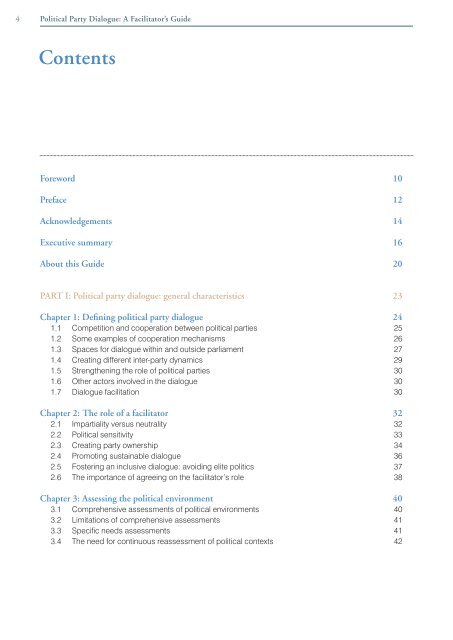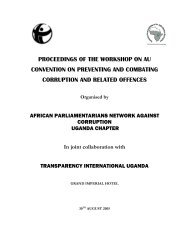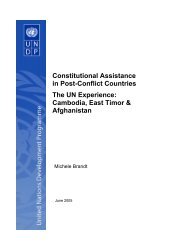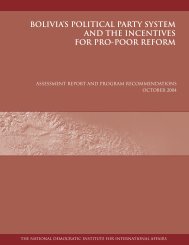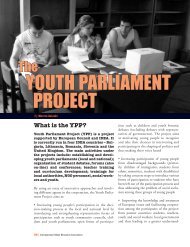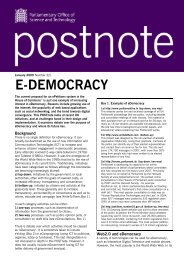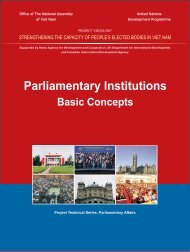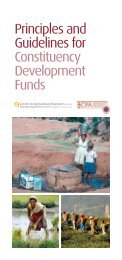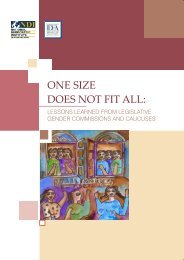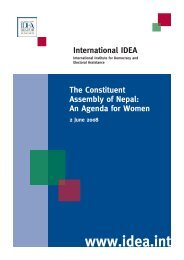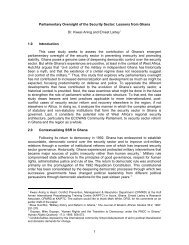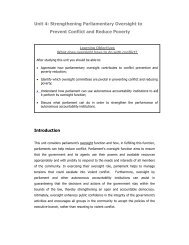- Page 1 and 2: Brechtje KempContributors: Sam van
- Page 3 and 4: International IDEA / NIMD / The Osl
- Page 5: International IDEA / NIMD / The Osl
- Page 9 and 10: International IDEA / NIMD / The Osl
- Page 11 and 12: International IDEA / NIMD / The Osl
- Page 13: ForewordInternational IDEA / NIMD /
- Page 16 and 17: 14 Political Party Dialogue: A Faci
- Page 18 and 19: 16 Political Party Dialogue: A Faci
- Page 20 and 21: 18 Political Party Dialogue: A Faci
- Page 22 and 23: 20 Political Party Dialogue: A Faci
- Page 24 and 25: 22 Political Party Dialogue: A Faci
- Page 29 and 30: Chapter 1International IDEA / NIMD
- Page 31 and 32: Chapter 1International IDEA / NIMD
- Page 33 and 34: Chapter 1International IDEA / NIMD
- Page 35 and 36: Chapter 2International IDEA / NIMD
- Page 37 and 38: Chapter 2International IDEA / NIMD
- Page 39 and 40: Chapter 2International IDEA / NIMD
- Page 41 and 42: Chapter 2International IDEA / NIMD
- Page 43 and 44: Chapter 3International IDEA / NIMD
- Page 45 and 46: Chapter 3International IDEA / NIMD
- Page 47: International IDEA / NIMD / The Osl
- Page 50 and 51: 48 Political Party Dialogue: A Faci
- Page 52 and 53: 50 Political Party Dialogue: A Faci
- Page 54 and 55: 52 Political Party Dialogue: A Faci
- Page 56 and 57:
54 Political Party Dialogue: A Faci
- Page 58 and 59:
56 Political Party Dialogue: A Faci
- Page 60 and 61:
58 Political Party Dialogue: A Faci
- Page 62 and 63:
60 Political Party Dialogue: A Faci
- Page 64 and 65:
62 Political Party Dialogue: A Faci
- Page 66 and 67:
64 Political Party Dialogue: A Faci
- Page 68 and 69:
66 Political Party Dialogue: A Faci
- Page 70 and 71:
68 Political Party Dialogue: A Faci
- Page 72 and 73:
70 Political Party Dialogue: A Faci
- Page 74 and 75:
72 Political Party Dialogue: A Faci
- Page 76 and 77:
74 Political Party Dialogue: A Faci
- Page 78 and 79:
76 Political Party Dialogue: A Faci
- Page 80 and 81:
78 Political Party Dialogue: A Faci
- Page 82 and 83:
80 Political Party Dialogue: A Faci
- Page 84 and 85:
82 Political Party Dialogue: A Faci
- Page 86 and 87:
84 Political Party Dialogue: A Faci
- Page 88 and 89:
86 Political Party Dialogue: A Faci
- Page 90 and 91:
88 Political Party Dialogue: A Faci
- Page 92 and 93:
90 Political Party Dialogue: A Faci
- Page 94 and 95:
92 Political Party Dialogue: A Faci
- Page 96 and 97:
94 Political Party Dialogue: A Faci
- Page 98 and 99:
96 Political Party Dialogue: A Faci
- Page 100 and 101:
98 Political Party Dialogue: A Faci
- Page 102 and 103:
100 Political Party Dialogue: A Fac
- Page 104 and 105:
102 Political Party Dialogue: A Fac
- Page 106 and 107:
104 Political Party Dialogue: A Fac
- Page 108 and 109:
106 Political Party Dialogue: A Fac
- Page 110 and 111:
108 Political Party Dialogue: A Fac
- Page 112 and 113:
110 Political Party Dialogue: A Fac
- Page 114 and 115:
112 Political Party Dialogue: A Fac
- Page 116 and 117:
114 Political Party Dialogue: A Fac
- Page 118 and 119:
116 Political Party Dialogue: A Fac
- Page 120 and 121:
118 Political Party Dialogue: A Fac
- Page 122 and 123:
120 Political Party Dialogue: A Fac
- Page 124 and 125:
122 Political Party Dialogue: A Fac
- Page 126 and 127:
124 Political Party Dialogue: A Fac
- Page 128 and 129:
126 Political Party Dialogue: A Fac
- Page 130 and 131:
128 Political Party Dialogue: A Fac
- Page 132 and 133:
130 Political Party Dialogue: A Fac
- Page 134 and 135:
132 Political Party Dialogue: A Fac
- Page 136 and 137:
134 Political Party Dialogue: A Fac
- Page 138 and 139:
136 Political Party Dialogue: A Fac
- Page 140 and 141:
138 Political Party Dialogue: A Fac
- Page 142 and 143:
140 Political Party Dialogue: A Fac
- Page 144 and 145:
142 Political Party Dialogue: A Fac
- Page 146 and 147:
144 Political Party Dialogue: A Fac
- Page 148 and 149:
146 Political Party Dialogue: A Fac
- Page 150 and 151:
148 Political Party Dialogue: A Fac
- Page 152 and 153:
150 Political Party Dialogue: A Fac
- Page 154 and 155:
152 Political Party Dialogue: A Fac
- Page 156 and 157:
154 Political Party Dialogue: A Fac
- Page 158 and 159:
156 Political Party Dialogue: A Fac
- Page 160 and 161:
158 Political Party Dialogue: A Fac
- Page 162 and 163:
160 Political Party Dialogue: A Fac
- Page 164 and 165:
162 Political Party Dialogue: A Fac
- Page 166 and 167:
164 Political Party Dialogue: A Fac
- Page 168:
‘Facilitating dialogue and seekin


